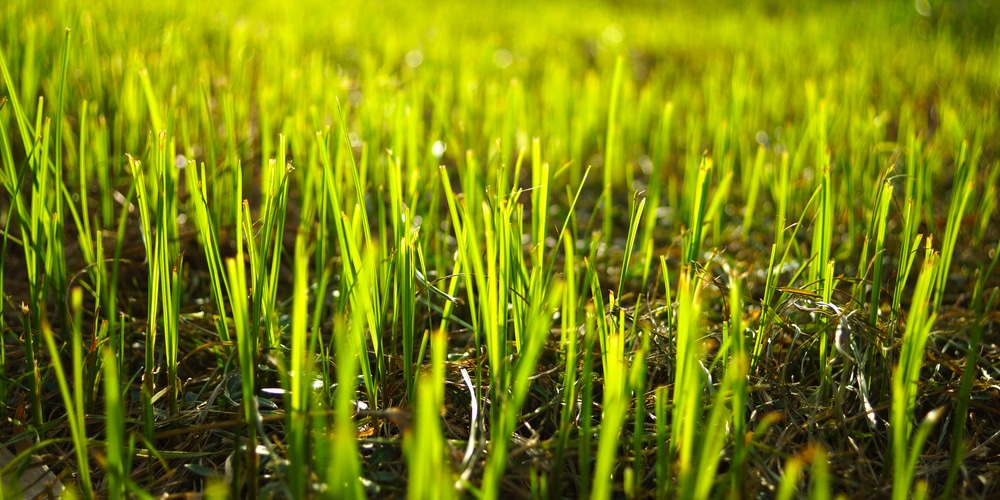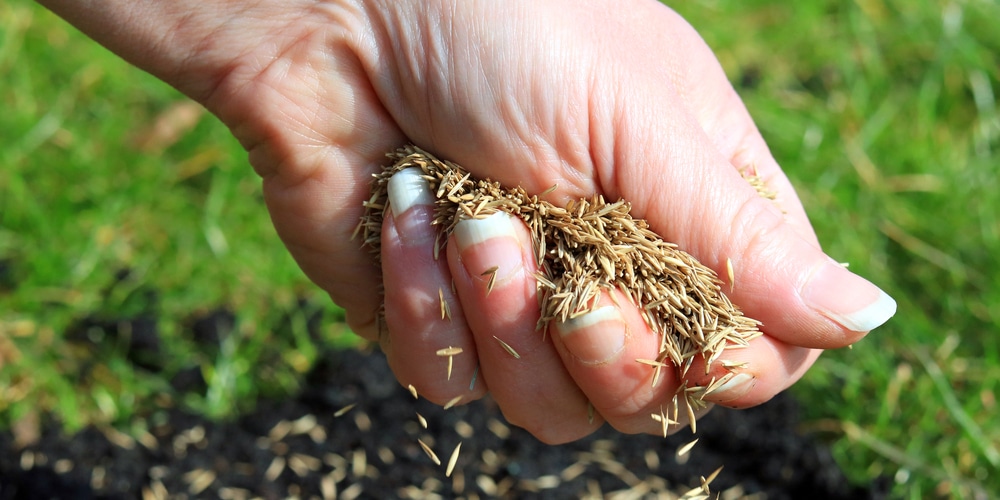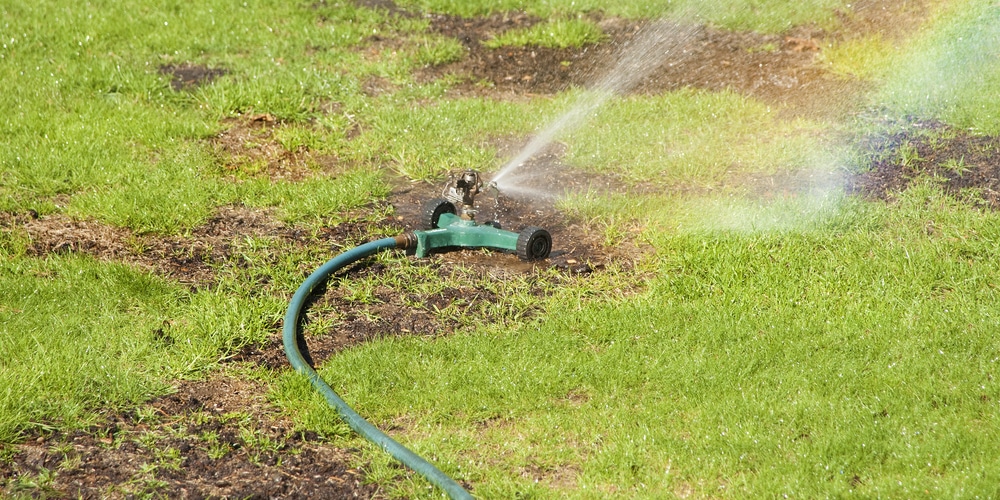Grass seed pricing has become a notable topic among homeowners and gardening enthusiasts.
The cost of grass seed (calculated by cost per 1000 ft) is influenced by a myriad of factors that reach beyond the simple dynamics of agriculture.
Critically, the balance between supply and demand plays a fundamental role in shaping prices.
High demand periods, often coinciding with favorable planting seasons, can drive prices up, while the supply side is equally challenged by a range of issues from crop failures to variable yields brought about by environmental factors such as unpredictable weather and pest infestations.

Additionally, the seed market is affected by the type of grass varieties available, with certain high-quality, drought-resistant or specialized seeds commanding a premium.
On top of the agricultural costs, prices are further shaped by the processes of distribution and retail markup.
As grass seeds progress from the farms to consumers, each step in the supply chain adds additional costs.
These can include handling fees, storage costs, transport expenses, and the final markup by retailers, all of which contribute to the retail price paid by the end consumer.
Key Takeaways
- Grass seed pricing is influenced by supply and demand, crop viability, and seasonal factors.
- Specialized grass varieties and enhanced seed types often have higher costs.
- The final retail price includes additional expenses incurred through the distribution chain.
Affordable Grass Seed
Cost Factors for Grass Seed
The pricing of grass seeds is influenced by several specific factors that impact the bottom line. From production to the store shelf, these determinants each carry their weight in the final cost.
Seed Production and Harvesting
Seed production is a resource-intensive process, involving precise agricultural practices.
Producers invest in high-quality soil, irrigation systems, and often have to deal with natural unpredictability which can affect yield. Additionally, the harvesting process requires specialized equipment and labor.
Seed Quality and Varieties
Developing and maintaining superior quality and specialized grass seed varieties is a significant factor.
These seeds are often the result of extensive research and breeding programs to ensure traits like drought resistance, shade tolerance, or particular color and texture characteristics.
- Research: Breeding programs, genetic research, disease resistance studies.
- Development: Field trials, germination tests, quality control measures.
Packaging and Branding
Lastly, costs are accrued in packaging and branding, which are critical for product differentiation and market appeal.
High-quality materials for packaging, coupled with marketing efforts, contribute to the overall expense.
- Packaging materials: Bags, coatings, labels, and printing.
- Branding: Advertising campaigns, market research, trademark registration.
Market Influences on Grass Seed Pricing
The pricing of grass seed is a complex subject influenced by a variety of market factors. These include the interplay of supply and demand, seasonal changes, and broader economic conditions.
Supply and Demand Dynamics
The cost of grass seed is closely tied to supply and demand dynamics.
When demand outstrips supply, perhaps due to increased lawn care or commercial landscaping activities, prices naturally escalate. Conversely, an oversupply might occur due to a bumper crop, driven by favorable farming conditions, leading to lower prices.
These fluctuations are constants in the agricultural market, impacting not only availability but also the quality and variety of grass seed offered.
- High Demand: Presumably sparked by factors such as new housing developments requiring lawn installations.
- Limited Supply: Possibly due to harvest failures or reduction in seed production areas.
Seasonal Variations
Price shifts also occur in response to seasonal variations.
Grass seed typically experiences higher demand in the spring and fall, correlating with the prime sowing seasons. Farmers and producers anticipate these shifts, but unexpected weather patterns can disrupt the cycle, influencing the cost.
For instance, an unseasonably cold spring can delay seeding which then concentrates demand into a narrower time frame, exacerbating price increases.
- Spring Rush: Increased demand as homeowners prepare for summer.
- Fall Planting: Ideal for seeding, causing another peak in demand.
Economic Fluctuations
Finally, economic fluctuations play a substantial role.
Currency value changes can affect the import and export balance, thus altering the cost structure for seeds both domestically and internationally. Input costs, such as fuel for agricultural machinery and transport or labor wages, also feed directly into the final price of the seed.
These factors are often unpredictable and add a level of volatility to grass seed pricing.
- Currency Values: Impacting international trade of grass seeds.
- Input Costs: Including fuel, labor, and transportation.
Distribution and Retail Markup
When considering the pricing of grass seed, distribution costs and retailer markups play pivotal roles. The journey from farms to store shelves encapsulates a range of expenses, often reflecting in the final price paid by the consumer.
Transportation Costs
Transporting grass seed from producers to retailers involves logistical expenses that vary depending on distance, fuel costs, and the mode of transport.
Fuel price fluctuations can particularly impact the cost. The shipping process might include:
- Truck transport from the farm to a packaging facility
- Rail or sea freight for long-distance or international movement
- Air freight for expedited orders, which is significantly more expensive
Retailer Pricing Strategies
Retailers determine final pricing strategies that include markup to cover their own costs and to ensure a profit.
These costs can include, but are not limited to:
- Operations: Rent, utilities, employee wages
- Marketing: Advertising, promotions, and in-store displays
- Inventory management: Storage, stocking, and loss from unsold inventory
Retail markups can vary, often ranging from a moderate percentage to over twice the wholesale cost, depending on factors like product demand, retailer business model, and competition.
Frequently Asked Questions
This section aims to shed light on common inquiries regarding the expense of grass seed.
What factors contribute to the high cost of grass seed?
Several factors increase the price of grass seed, including the cost of farming, supply shortages, and the expense of developing high-quality grass varieties. Advances in grass breeding and stringent quality controls also inflate the costs.
Has there been an increase in grass seed prices in recent years?
Yes, in recent years, the prices of grass seed have seen a rise attributed to factors such as increased demand, farming costs, and occasional crop failures that disrupt the supply chain.
Can environmental or seasonal conditions affect grass seed pricing?
Environmental and seasonal conditions significantly impact grass seed pricing. Drought, poor weather conditions, and climate fluctuations can all lead to reduced harvests and higher prices due to lowered supply against steady demand.
Are there any recent shortages in grass seed supply impacting its price?
Recent shortages, often caused by droughts, export restrictions, or crop diseases, have been known to impact the supply of grass seed, leading to higher market prices.
How does the cost of growing grass from seed compare to other methods?
Growing grass from seed is generally less expensive up-front compared to methods like sod installation. However, seeding requires more time and care for establishment, which can contribute to long-term costs.
What is the typical price range for quality grass seed?
The price range for quality grass seed can vary widely depending on type, brand, and quantity. Premium varieties can cost significantly more, with prices ranging from a few dollars to several hundreds of dollars per pound.
How Is Grass Seed Made?
Grass seed is made by harvesting mature grasses and then separating the seed from the stems and husks. The seeds are then cleaned, graded, and packaged for sale.
Depending on the quality of the grass seed, there may be additional processes required to create a quality product like testing for germination rate or screening for weed seeds.
What types of grass seeds are available?
There are many types of grass seeds on the market, but they generally fall into two categories; cool-season and warm-season grasses.
Cool-season grasses like Kentucky bluegrass, ryegrass, and tall fescue do best in cooler climates with moderate temperatures. Examples of warm-season grasses are Bermuda and Zoysia grass. These are best suited for hotter climates.
You can also buy weed and feed type grass seeds which contain a combination of grass seed and weed control products. These are great value and can help you maintain a weed-free lawn.
Some grass seeds are also coated in fertilizer to help the new grass seedlings grow.
What is the cheapest type of grass seed?
The cheapest type of grass seed is usually a basic, single-type seed such as perennial ryegrass. This type of grass seed can be used for many different areas and climates. It tends to be more cost-effective because you don’t need to buy a fancy mix or additional weed control products.
Is Grass Seed Cheaper Than Sod?
In general, grass seed is cheaper than sod. This is because it takes more labor and materials to produce a roll of sod, which increases the cost. However, depending on the type or brand of seed you choose, it can be just as expensive as buying sod.
Labor costs also need to be taken into account when calculating how much it will cost to cover your lawn with either grass seed or sod.
Conclusion
Overall, grass seed is an investment in your yard that will pay off in a beautiful green landscape. It’s expensive because it takes a lot of labor and materials to make, and you need large quantities to cover a yard. However, if you choose the right kind of grass seed for your location or climate, it can be an affordable way to get a beautiful lawn.
It’s important to remember that grass seed is cheaper than sod, but the types and brands of grass seed you choose will affect how expensive it is.
With the right care and maintenance, your grass seed should grow into a healthy green lawn. Invest in quality grass seed for the best results!
Last update on 2025-06-06 / Affiliate links / Images from Amazon Product Advertising API





